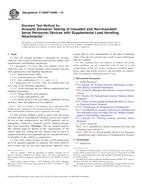Potrebujeme váš súhlas na využitie jednotlivých dát, aby sa vám okrem iného mohli ukazovať informácie týkajúce sa vašich záujmov. Súhlas udelíte kliknutím na tlačidlo „OK“.
ASTM F1430/F1430M-10
Standard Test Method for Acoustic Emission Testing of Insulated and Non-Insulated Aerial Personnel Devices with Supplemental Load Handling Attachments
Automaticky preložený názov:
Štandardná skúšobná metóda pre akustické emisie testovanie izolovaných a neizolovaných Aerial Personálne zariadení s Company Manipulátory Prílohy
NORMA vydaná dňa 1.4.2010
Informácie o norme:
Označenie normy: ASTM F1430/F1430M-10
Poznámka: NEPLATNÁ
Dátum vydania normy: 1.4.2010
Kód tovaru: NS-50266
Počet strán: 10
Približná hmotnosť: 30 g (0.07 libier)
Krajina: Americká technická norma
Kategória: Technické normy ASTM
Anotácia textu normy ASTM F1430/F1430M-10 :
Keywords:
acoustic, aerial devices, emission, equipment, Transmission lines (electric), Vehicle-mounted insulated material handling aerial devices (IMHAD), Acoustic emission (AE) testing, Aerial devices, Electrical power systems, Electrical protective equipment, Extensible boom aerial personnel device, IMHAD (insulated material handling aerial devices), Live line tools, Loading tests, Microseismic activity, Pass-fail test, Supplemental load handling attachments, Transient stress waves
Doplňujúce informácie
| Significance and Use | ||||||||||||||||||||||||||||
|
This test method provides a means of evaluating acoustic emissions generated by the rapid release of energy from localized sources within an APD under controlled loading. The resultant energy releases occur during intentional application of a controlled predetermined load. These energy releases can be monitored and interpreted by qualified individuals. This test method permits testing of the major components of an aerial device under controlled loading. This test method utilizes objective criteria for evaluation and may be discontinued at any time to investigate a particular area of concern or prevent a fault from continuing to ultimate failure. This test method provides a means of detecting acoustic emissions that may be defects or irregularities, or both, affecting the structural integrity or intended use of the aerial device. Sources of acoustic emission found with this test method shall be evaluated by either more refined acoustic emission test methods or other nondestructive techniques (visual, liquid penetrant, radiography, ultrasonics, magnetic particle, etc.). Other nondestructive tests may be required to locate defects present in APDs. Defective areas found in aerial devices by this test method should be repaired and retested as appropriate. Repair procedure recommendations are outside the scope of this test method. |
||||||||||||||||||||||||||||
| 1. Scope | ||||||||||||||||||||||||||||
|
1.1 This test method describes a procedure for acoustic emission (AE) testing of aerial personnel devices (APDs) with supplemental load handling attachments. 1.1.1 Equipment Covered—This test method covers the following types of vehicle-mounted aerial personnel devices with supplemental load handling attachments: 1.1.1.1 Extensible-boom APDs, 1.1.1.2 Articulating-boom APDs, and 1.1.1.3 Any combination of 1.1.1.1 and 1.1.1.2. 1.1.2 Equipment Not Covered—This test method does not cover any of the following equipment: 1.1.2.1 Aerial personnel devices without supplemental load handling attachments, 1.1.2.2 Digger-derricks with platform, 1.1.2.3 Cranes with platform, and 1.1.2.4 Aerial devices with load-lifting capabilities located anywhere other than adjacent to the platform. Note 1—This test method is not intended to be a stand-alone NDT method for the verification of the structural integrity of an aerial device. Other NDT methods should be used to supplement the results. 1.2 The AE test method is used to detect and area-locate emission sources. Verification of emission sources may require the use of other nondestructive test (NDT) methods, such as radiography, ultrasonics, magnetic particle, liquid penetrant, and visual inspection. (Warning—This test method requires that external loads be applied to the superstructure of the vehicle under test. During the test, caution must be taken to safeguard personnel and equipment against unexpected failure or instability of the vehicle or components.) 1.3 The values stated in either SI units or inch-pound units are to be regarded separately as standard. The values stated in each system may not be exact equivalents; therefore, each system shall be used independently of the other. Combining values from the two systems may result in non-conformance with the standard. 1.4 This standard does not purport to address all of the safety problems, if any, associated with its use. It is the responsibility of the user of this standard to establish appropriate safety and health practices and determine the applicability of regulatory limitations prior to use. |
||||||||||||||||||||||||||||
| 2. Referenced Documents | ||||||||||||||||||||||||||||
|
Odporúčame:
EviZak - všetky zákony vrátane ich evidencie na jednom mieste
Poskytovanie aktuálnych informácií o legislatívnych predpisoch vyhlásených v Zbierke zákonov od roku 1945.
Aktualizácia 2x v mesiaci !
Chcete vedieť viac informácii ? Pozrite sa na túto stránku.




 Cookies
Cookies
